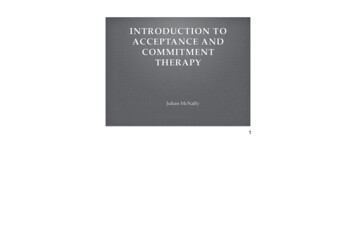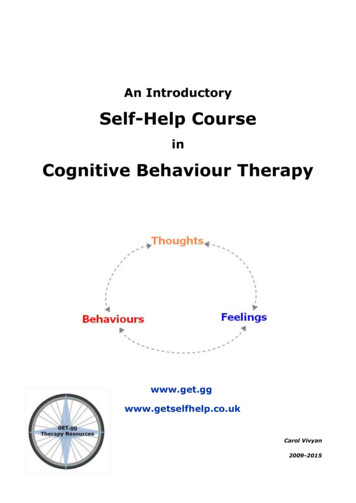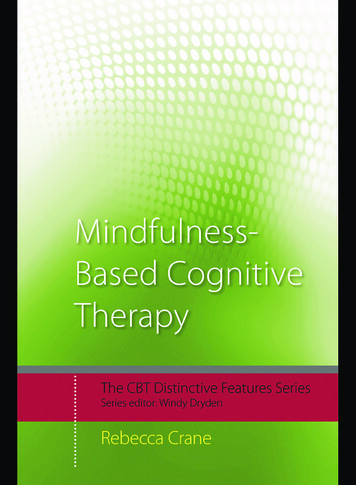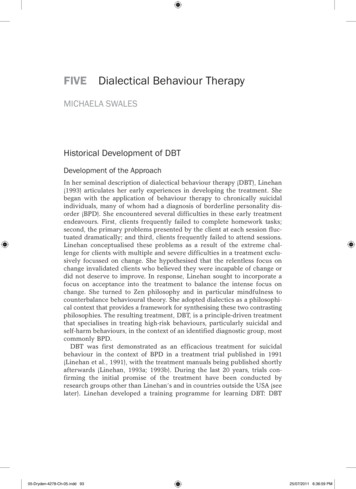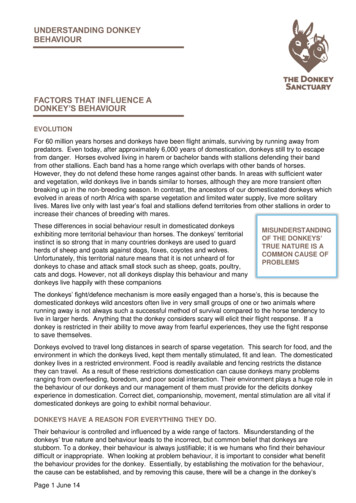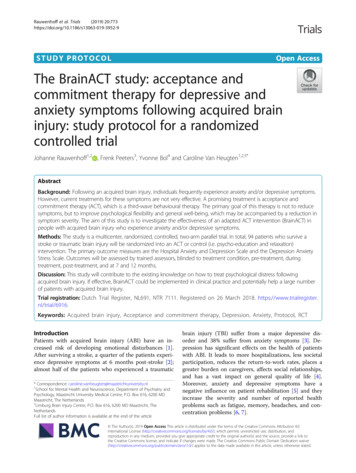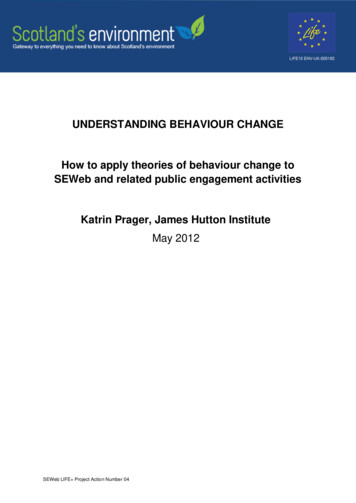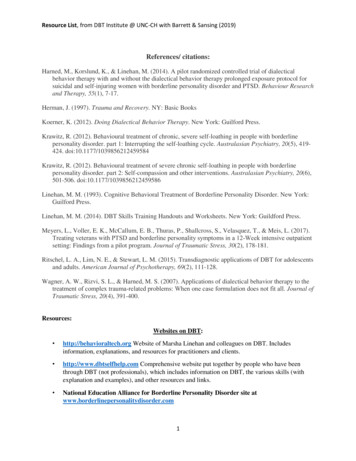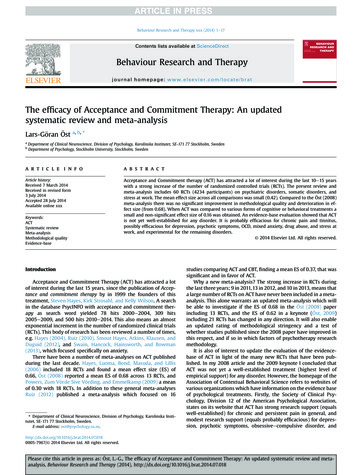
Transcription
Behaviour Research and Therapy xxx (2014) 1e17Contents lists available at ScienceDirectBehaviour Research and Therapyjournal homepage: www.elsevier.com/locate/bratThe efficacy of Acceptance and Commitment Therapy: An updatedsystematic review and meta-analysis a, b, * ran OstLars-GoabDepartment of Clinical Neuroscience, Division of Psychology, Karolinska Institutet, SE-171 77 Stockholm, SwedenDepartment of Psychology, Stockholm University, Stockholm, Swedena r t i c l e i n f oa b s t r a c tArticle history:Received 7 March 2014Received in revised form3 July 2014Accepted 28 July 2014Available online xxxAcceptance and Commitment therapy (ACT) has attracted a lot of interest during the last 10e15 yearswith a strong increase of the number of randomized controlled trials (RCTs). The present review andmeta-analysis includes 60 RCTs (4234 participants) on psychiatric disorders, somatic disorders, and (2008)stress at work. The mean effect size across all comparisons was small (0.42). Compared to the Ostmeta-analysis there was no significant improvement in methodological quality and deterioration in effect size (from 0.68). When ACT was compared to various forms of cognitive or behavioral treatments asmall and non-significant effect size of 0.16 was obtained. An evidence-base evaluation showed that ACTis not yet well-established for any disorder. It is probably efficacious for chronic pain and tinnitus,possibly efficacious for depression, psychotic symptoms, OCD, mixed anxiety, drug abuse, and stress atwork, and experimental for the remaining disorders. 2014 Elsevier Ltd. All rights reserved.Keywords:ACTSystematic reviewMeta-analysisMethodological qualityEvidence-baseIntroductionAcceptance and Commitment Therapy (ACT) has attracted a lotof interest during the last 15 years, since the publication of Acceptance and commitment therapy by in 1999 the founders of thistreatment, Steven Hayes, Kirk Strosahl, and Kelly Wilson. A searchin the database PsycINFO with acceptance and commitment therapy as search word yielded 78 hits 2000e2004, 309 hits2005e2009, and 500 hits 2010e2014. This also means an almostexponential increment in the number of randomized clinical trials(RCTs). This body of research has been reviewed a number of times,e.g. Hayes (2004), Ruiz (2010), Smout Hayes, Atkins, Klausen, andDuguid (2012), and Swain, Hancock, Hainsworth, and Bowman(2013), which focused specifically on anxiety.There have been a number of meta-analyses on ACT publishedduring the last decade. Hayes, Luoma, Bond, Masuda, and Lillis(2006) included 18 RCTs and found a mean effect size (ES) of (2008) reported a mean ES of 0.68 across 13 RCTs, and0.66, Ost rde Sive Vo rding, and Emmelkamp (2009) a meanPowers, Zum Voof 0.30 with 18 RCTs. In addition to these general meta-analysesRuiz (2012) published a meta-analysis which focused on 16* Department of Clinical Neuroscience, Division of Psychology, Karolinska Institutet, SE-171 77 Stockholm, Sweden.E-mail address: ost@psychology.su.se.studies comparing ACT and CBT, finding a mean ES of 0.37, that wassignificant and in favor of ACT.Why a new meta-analysis? The strong increase in RCTs duringthe last three years; 9 in 2011, 13 in 2012, and 10 in 2013, means thata large number of RCTs on ACT have never been included in a metaanalysis. This alone warrants an updated meta-analysis which will (2008) paperbe able to investigate if the ES of 0.68 in the Ost including 13 RCTs, and the ES of 0.62 in a keynote (Ost,2009)including 21 RCTs has changed in any direction. It will also enablean updated rating of methodological stringency and a test ofwhether studies published since the 2008 paper have improved inthis respect, and if so in which factors of psychotherapy researchmethodology.It is also of interest to update the evaluation of the evidencebase of ACT in light of the many new RCTs that have been published. In my 2008 article and the 2009 keynote I concluded thatACT was not yet a well-established treatment (highest level ofempirical support) for any disorder. However, the homepage of theAssociation of Contextual Behavioral Science refers to websites ofvarious organizations which have information on the evidence baseof psychological treatments. Firstly, the Society of Clinical Psychology, Division 12 of the American Psychological Association,states on its website that ACT has strong research support (equalswell-established) for chronic and persistent pain in general, andmodest research support (equals probably efficacious) for depression, psychotic symptoms, obsessiveecompulsive disorder, 5-7967/ 2014 Elsevier Ltd. All rights reserved. L.-G., The efficacy of Acceptance and Commitment Therapy: An updated systematic review and metaPlease cite this article in press as: Ost,analysis, Behaviour Research and Therapy (2014), http://dx.doi.org/10.1016/j.brat.2014.07.018
/ Behaviour Research and Therapy xxx (2014) 1e17L.-G. Ost2mixed anxiety. Secondly, SAMHSA's National Registry of EvidenceBased Programs and Practices listed ACT as an evidence-basedtreatment in March 2011. However, that decision was based ononly three studies (Bach & Hayes, 2002; Bond & Bunce, 2000;Twohig et al., 2010), which is remarkable when 28 RCTs had beenpublished by the end of 2010. There is no information regardinghow these three studies were selected.The aims of the present article were to: (2008) Update the systematic review and meta-analysis of Ost Compare the early studies (included in Ost,2008, n ¼ 13) withthe later studies (n ¼ 47) regarding methodological stringencyand effect size. Replicate the Ruiz (2012) comparison of ACT vs CBT in a largersample of studies. Evaluate the evidence-base status of ACT for the different disorders it has been tried for.Fig. 1. Flowchart of the inclusion of studies.MethodMethodological qualityLiterature searchPsycINFO and PubMed were searched from 1985 to November2013 with the following search words: Acceptance or ACT, andRandomized controlled trial or RCT or random*. I also used the listof RCTs published on the website of the Association of ContextualBehavioral Science by May 2013.All abstracts were read and when there was an indication of agroup of patients receiving the particular treatment beingcompared with another group in a randomized clinical trial (RCT)the full-text article was retrieved. Studies using single case designswere excluded since there is no consensus yet regarding thecalculation of effect sizes. The reference lists in the retrieved articles were then checked against the database search and anyother articles that might fulfill the inclusion criteria wereretrieved.Inclusion criteriaIn order to be included in the review and meta-analysis a studyhad to: be published, or in press, in an English language journal randomly allocate participants to either treatment and control,or to two or more active treatments have participants with either a psychiatric disorder, a somaticdisorder, or stress reactions in work situationsExcluded from the review and meta-analysis were: Studies with normal people not applying for treatment RCTs with only 1e2 components of ACT Reanalysis of a subsample from a previously published RCTFig. 1 shows a flowchart of the inclusions of studies in the current meta-analysis.Classification of the RCTsBased on the participants in the studies RCTs were classified ascontaining a psychiatric disorder (anxiety disorders, depression,mixed anxiety-depression, psychotic symptoms, drug abuse, nicotine dependence, trichotillomania, and borderline personality disorder), a somatic disorder (pain of various types, headache,epilepsy, tinnitus, overweight/obesity, cancer, diabetes and multiple sclerosis), or stress in work situations.In order to assess the quality of the research methodology in RCTsvarious scales have been developed, e.g. the Jadad criteria (Jadadet al., 1996). They are, however, usually constricted to rather fewitems rated as present or absent. This means that the range of scoresis small (e.g. 2e4 in Cavanagh, Strauss, Forder, & Jones, 2014) withensuing difficulties of showing a relationship between methodological quality and effect size. Based on previous work by Tolin (1999) I developed a scale containing 22 items (Ost,2008) with atheoretical range of 0e44. When used in my 2008 meta-analysis thetotal score for the ACT studies ranged from 10 to 27. Thus, thereshould not be a problem of “restriction-of-range” with this scale.The psychotherapy outcome study methodology rating scaleThe scale consists of the following items: 1. Clarity of sampledescription, 2. Severity/chronicity of the disorder, 3. Representativeness of the sample, 4. Reliability of the diagnosis in question, 5.Specificity of outcome measures, 6. Reliability and validity ofoutcome measures, 7. Use of blind evaluators, 8. Assessor training, 9.Assignment to treatment, 10. Design, 11. Power analysis, 12. Assessment points, 13. Manualized, replicable, specific treatment programs,14. Number of therapists, 15. Therapist training/experience, 16.Checks for treatment adherence, 17. Checks for therapist competence, 18. Control of concomitant treatments, 19. Handling of attrition, 20. Statistical analyses and presentation of results, 21. Clinicalsignificance, 22. Equality of therapy hours (for non-WLC designsonly). Each item is rated as 0 ¼ poor, 1 ¼ fair, and 2 ¼ good, and eachstep has a verbal description of one or more sentences.Psychometric dataThe internal consistency of the scale was good with a Cronbach'sa of 0.81. In order to assess the inter rater reliability of the scaleadvanced graduate students in clinical psychology received 6 h oftraining in the use of the scale by the author, with various outcomestudies as training examples. Then the students rated a randomselection of 20% of the studies and the ratings were compared withthose of the author. The intra-class correlation for the total scorewas 0.90, and the kappa coefficients on the individual items variedbetween 0.50 and 1.00, with a mean of 0.73, indicating a good interrater reliability.Meta-analysisIn the current meta-analysis the primary outcome measure foreach study was used to calculate effect size. If a study did not L.-G., The efficacy of Acceptance and Commitment Therapy: An updated systematic review and metaPlease cite this article in press as: Ost,analysis, Behaviour Research and Therapy (2014), http://dx.doi.org/10.1016/j.brat.2014.07.018
/ Behaviour Research and Therapy xxx (2014) 1e17L.-G. Ostindicate which was the primary measure I decided which it wasbased on the disorder focused in the study. In one specific study(Buhrman et al., 2013) the authors designed as primary a measurethat other pain studies used as process measure. In this case Idecided to use the same measure as most other pain studiesdescribed as primary measure. I had to use the data included in eachstudy, which in some studies (mainly older) were completer dataand in some studies (mainly more recent ones) were intent-to-treat(ITT) data. When a study presented both sets of data ITT data wereused.The effect size (ES) was calculated as: (MACT Mcomparison)/SDpooled, separately for post- and follow-up assessment. Beforepooling the effect sizes I screened for statistical outliers, defined asbeing outside M 2SD. Eight (4.1%) of the ESs were outliers. Insteadof deleting those ESs from the analysis Winsorising (Lipsey &Wilson, 2001) was used by reducing outliers to the exact value ofM þ 2SD. The software Comprehensive Meta-Analysis, version 2.2(CMA; Biostat Inc., 2010) was used for all analyses and to correct forsmall samples Hedges's g was calculated. Cohen's rule-of-thumb forclassification of ES was used; an ES of 0.20e0.49 is consideredsmall, 0.50e0.79 as moderate, and 0.80 as large.Each study contributed with an average of 3.2 ESs (post- andfollow-up combined). For studies with more than one measure pertime point the ESs were combined into a mean ES for that study, inorder to include only one ES per study in the pooled mean ES. Arandom effects model was used since it cannot be assumed that theESs come from the same population as studies of psychiatric disorders, somatic disorders, and stress at work are included in themeta-analysis.Heterogeneity among ES's was assessed with the Q-statistic andthe I-square statistic. The possibility of publication bias wasanalyzed with the trim-and-fill method of Duval and Tweedie(2000) as well as Egger's regression intercept (Egger, Davey Smith,Schneider, & Minder, 1997). Moderator analyses of continuous variables were carried out with meta-regression and for categoricalvariables with sub-group analysis using the mixed effect model.Criteria for evidence-based treatmentsThe criteria developed by the APA Division 12 Task Force(Chambless et al., 1996; 1998) and later modified by Silverman andHinshaw (2008) were used. The degree of empirical support forvarious treatments was classified into four categories.Well-established treatments1. At least two good group-design studies, conducted by independent research teams, demonstrating efficacy by showing thetreatment to be: a) statistically significantly superior to pill orpsychological placebo, or to another treatment, or b) equivalentto an already established treatment in experiments with statistical power being sufficient to detect moderate differences.2. Treatment manuals were used for the treatment.3. Conducted with a population, treated for specified problems, forwhom inclusion criteria have been delineated in a reliable, validmanner.4. Reliable and valid outcome assessment measures tapping theproblems targeted for change were used.5. Appropriate data analyses were applied.Probably efficacious treatments1. At least two good experiments showing that the treatment issuperior (statistically significantly so) to a wait-list controlgroup, or2. One or more good experiments meeting the well-establishedtreatment criteria with the one exception of having been conducted by at least two by independent investigatory teams.3Possibly efficacious treatmentsAt least one good study showing the treatment to be efficaciousin the absence of conflicting evidence.Experimental treatmentsTreatment not yet tested in trials meeting task force criteria formethodology (modified from Silverman & Hinshaw, 2008).The Society of Clinical Psychology, which is Division 12 ofAmerican Psychological Association, has a website on Researchsupported Psychological Treatments. In their evaluation peopleresponsible for this website use the same criteria as the originalAPA Task Force but with different names. Well-established is calledstrong research support, probably efficacious is called modestresearch support, possibly efficacious has no counterpart, andexperimental is called no research support. These terms will beused when comparing my evaluation of ACT's evidence-base statuswith the evaluation of this website for the disorders that coincidewith this review and that of the website.ResultsDescription of the ACT studiesThe 60 studies originated from USA (n ¼ 28), Sweden (n ¼ 14),Great Britain (n ¼ 7), Australia (n ¼ 5), Finland (n ¼ 2), and one eachfrom Canada, Iran, New Zealand, and Spain. A total of 4234 participants started treatment or control conditions and the attritionrate varied between 0 and 70% with a mean of 21%. The proportionof women varied between 0 (Lappalainen et al., 2013) and 100%(e.g. Zettle & Hayes, 1986) with a mean of 68%. Mean age of theparticipants across studies was 39.9 years (SD ¼ 9.7; range of studymeans 14.8e70.8).Various background data for the ACT RCTs are described inTable 1. Comparisons of studies on psychiatric disorders, somaticdisorders and stress in work situations are displayed in Table 2. On11 of the 13 variables there were no significant differences betweenthe three categories of studies. However, mean age of the samplesin psychiatric disorders was significantly lower than that of somaticdisorder samples, whereas stress samples did not differ significantly from either of these. The mean number of therapy sessionswas significantly higher for studies with psychiatric patients thanin studies with stress participants, whereas that of somatic studiesdid not differ from either.Methodological dataTable 3 displays the mean scores on the Psychotherapy outcomestudy methodology rating form for all RCTs and divided on thethree categories. An initial test of homogeneity of variances wassignificant for half of the 22 items in the scale. This is understandable since the mean for the stress studies was 0.00 for items 4,7, 8, 11, 16, 17, 18, and 2.00 for items 20, and 22; on these items thevariance is zero. Consequently, for comparisons between the threecategories the post-hoc test by Games-Howell, which does notassume equal variance, was used. On five of the items studies ofpsychiatric disorders yielded a significantly higher mean score thanstudies of somatic studies, which did not differ from stress studies.These were: 7. Use of blind evaluators, 8. Assessor training, 10.Design, 16. Checks for treatment adherence, and 17. Checks fortherapist competence. On another two items; 4. Reliability of thediagnosis in question, and 11. Power analysis, studies of psychiatricdisorders had higher mean scores than stress studies, while notdiffering significantly from that of somatic disorder studies. Themeans for psychiatric and somatic disorders did not differ L.-G., The efficacy of Acceptance and Commitment Therapy: An updated systematic review and metaPlease cite this article in press as: Ost,analysis, Behaviour Research and Therapy (2014), http://dx.doi.org/10.1016/j.brat.2014.07.018
/ Behaviour Research and Therapy xxx (2014) 1e17L.-G. Ost4Table 1Background data for the included ACT-studies in the meta-analysis.DisorderStudyComparison N total N/cell Attr.Attr. N compl. Compl./ Percent Mean # of# of# of # of F-upTotal % ACT %cellwomen agetherapists weeks Sess. hours ymptomsPsychoticsymptomsMath anxietyTest anxietyGADGADZettle and Hayes (1986)Zettle and Rains (1989)Hayes et al. (2011)Folke et al. (2012)Petersen and Zettle (2009)Bach and Hayes 0Gaudiano andHerbert (2006)White et al. (2011)TAU4020TAU27Shawyer et al. (2012)OtherZettle (2003)Brown et al. (2011)Roemer et al. (2008)Wetherell, Afari,Ayers, et al. (2011)Hayes-Skeltonet al. (2013)Twohig et al. (2010)Arch et al. (2012)England et al. (2012)Kocovski et al. (2013)Hayes (2004)Smout et al. (2010)Luoma et al. (2012)Stotts et al. (2012)Lanza and ndez (2013)MeneGifford et al. 6Gifford et al. (2011)MedBricker et al. (2013)Woods et al. (2006)Gratz andGunderson (2006)Morton et al. (2012)Forman et al. (2007)Lappalainen et al. (2007)Dahl et al. (2004)Wicksell et al. (2008)Wicksell et al. (2009)Wicksell et al. (2013)Johnston et al. (2010)Thorsell et al. (2011)Wetherell, Afari,Rutledge, et al. (2011)Buhrman et al. (2013)McCracken et al. (2013)Mo'tamedi et al. (2012)Lundgren et al. (2006)Lundgren et al. (2008)Westin et al. (2011)Hesser et al. (2012)Rost et al. (2012)Lillis et al. (2009)GADOCDMixed groupSocial anxietySocial anxietyDrug abuseDrug abuseDrug abuseDrug abuseDrug ependenceTrichotillomaniaBorderline PDBorderline PDMixed groupMixed 03.14.0323180125.05.338193640.01343.0413.5 CBT8140.5 6.312303151.5 516.012.09.012.010.01.212.06.0630121261203Tapper et al. (2009)WLC62311325.85126.510041.01336.03Weineland et al. (2012)TAU3919.5 15.421.13316.59043.1NI885.50Forman, Butryn,et al. (2013)Forman, Hoffman,et al. (2013)Gregg et al. (2007)Nordin andRorsman (2012)Bond and Bunce 041335631OtherCBT812140.5 18.510.5 6521.75036.4NI1427.8 L.-G., The efficacy of Acceptance and Commitment Therapy: An updated systematic review and metaPlease cite this article in press as: Ost,analysis, Behaviour Research and Therapy (2014), http://dx.doi.org/10.1016/j.brat.2014.07.018
/ Behaviour Research and Therapy xxx (2014) 1e17L.-G. Ost5Table 1 (continued )DisorderStudyComparison N total N/cell Attr.Attr. N compl. Compl./ Percent Mean # of# of# of # of F-upTotal % ACT %cellwomen agetherapists weeks Sess. hours monthsStressStressStressStressStressStressFlaxman and Bond (2010a)Flaxman and Bond (2010b)Brinkborg et al. (2011)Bethay et al. (2013)Lloyd et al. (2013)Lappalainen et al. .09.09.08.0000366Note: CBT ¼ Cognitive Behavior Therapy, TAU ¼ Treatment-as-usual, WLC ¼ Waitlist control, Med ¼ medication, IPP ¼ Innovation Promotion Program, SIT ¼ Stress InoculationTreatment, NI ¼ no information.significantly on six items, whereas both differed from those ofstress studies. These were: 1. Clarity of sample description, 2.Severity/chronicity of the disorder, 3. Representativeness of thesample, 5. Specificity of outcome measures, 18. Control ofconcomitant treatments, and 21. Clinical significance.Somatic disorder studies never had a higher mean than psychiatric disorders, but stress studies had significantly higher meanthan psychiatric disorder studies on two items; 20. Statistical analyses and presentation of results, and 22. Equality of therapyhours. On both of these the difference between psychiatric andsomatic disorder studies was nonsignificant. Finally, there were nosignificant difference between the means for the various disorderson seven items; 6. Reliability and validity of outcome measures, 9.Assignment to treatment,12. Assessment points, 13. Manualized,replicable, specific treatment programs, 14. Number of therapists,15. Therapist training/experience, and 19. Handling of attrition. Onthe total mean score of the scale studies of psychiatric disorders(M ¼ 20.29) did not differ significantly from that of somatic disorders (M ¼ 18.14), whereas both were significantly higher thanthat of stress studies (M ¼ 12.86).In order to assess whether recent studies had a more stringentmethodology than earlier studies a comparison was made between (2008) review and the 47 studiesthe 13 studies included in the Ostpublished since then. Table 4 displays this comparison and thereare significantly higher means for recent studies on three of the 22items. However, on item 11. Power analysis, and item 17. Checks fortherapist competence, the early studies had a mean of 0.00, whichmakes t-test unsuitable. Instead the 0e2 scale was dichotomizedinto 0 vs. 1 þ 2 and tested with Fisher's exact test. This yielded atwo-tailed p-value of 0.10 for item 11 and 0.18 for item 17. Thus,only item 14. Number of therapists, showed a significantlyincreased mean in recent studies. The total score increased withonly 0.9 points (17.9e18.8) a non-significant change.DesignsThe designs used in the RCTs are described in Table 5. Therewere 66 comparisons in the 60 RCTs and the most common comparison was with some form of CBT (n ¼ 21), followed by (WLC,n ¼ 17), and TAU (n ¼ 15).Specific methodological issuesTreatment-as-usual control groupsA quarter of the RCTs used treatment-as-usual (TAU) as thecontrol condition. This is understandable from two aspects; it isethically defensible since all patients obtain treatment and the newtreatment can be compared with what is the standard care at theclinic in question. However, TAU has a number of drawbacks thatrarely are highlighted. Firstly, the treatment is not constant butchanges across time as the therapists learn new methods. Thismeans that the study does not compare A vs. B, but A1 vs. A2, whichleads to a lower power and more difficulties showing a significantdifference. Secondly, the sessions are usually not recorded and thusadherence and competence cannot be assessed. Thirdly, the patients often get markedly less therapy hours than those in the primary treatment. The last factor is illustrated in Table 6. There were15 RCTs comparing TAU with ACT plus TAU or ACT only. In 10 of the15 studies the TAU-condition got less therapy hours than theACT þ TAU-condition. This corresponds to a percentage differencevarying between 18 and 100, with a mean of 75%. Of the remainingfive studies three balanced the treatment time, and two (Petersen &Zettle, 2009; Wicksell, Melin, Lekander, & Olsson, 2009) even hadsomewhat more therapy time for the TAU-condition.Combining ACT with other treatment(s) or componentsIn this body of RCTs it is not uncommon that ACT is combinedwith some empirically supported treatment or components of sucha treatment into a package. However, in order to conclude howmuch, if anything, ACT contributes to the outcome it is necessary touse a dismantling design. Twenty of the 60 studies used componentsfrom, or complete other treatments, in addition to ACT, but none ofthe studies used a dismantling design. Examples of this type ofstudies are Woods, Wetterneck, and Flessner (2006) combining ACTwith habit reversal training in the treatment of trichotillomania,Gratz and Gunderson (2006) using a combination of ACT, Dialectical Behavior Therapy (DBT), BT, and emotion-focused therapy forborderline personality disorder, and Lundgren, Dahl, Melin, andKies (2006) and Lundgren, Dahl, Yardi, and Melin (2008)combining ACT with behavioral seizure control techniques for patients with epilepsy.Drawing conclusion of equivalent effects from superiority designsA non-significant difference on the primary measure does notallow the conclusion that the two compared treatments are equallygood. This requires a noninferiority or an equivalence design (e.g.Walker & Nowacki, 2011). However, equivalence can be tested in asuperiority design that yielded a non-significant effect, provided alarge enough cell size (at least 30 according to the APA, Division 12Task Force criteria, 1995). The RCTs in this review contained 47comparisons of ACT with another treatment, and 29 (62%) found nosignificant difference between them. Reading the abstracts onefinds that seven of these described ACT and the compared treatment as yielding equivalent outcomes, however, none did anequivalence test, even if some of the studies (e.g. Flaxman & Bond,2010a; Forman, Herbert, Moitra, Yeomans, & Geller, 2007) had cellsizes of 30 or more.Lack of statistical powerPsychotherapy outcome studies are usually very expensive andit is questionable to start such a study if it is clearly underpowered,i.e. if the chance of detecting a significant difference is markedlylower than the recommended 80%. The sample power table for ttest in Kazdin (2003, p. 444) indicates that if a researcher expects toobtain a large effect size (d ¼ 0.80) 26 participants per condition isnecessary for 80% power. However, if the expected effect size is L.-G., The efficacy of Acceptance and Commitment Therapy: An updated systematic review and metaPlease cite this article in press as: Ost,analysis, Behaviour Research and Therapy (2014), http://dx.doi.org/10.1016/j.brat.2014.07.018
/ Behaviour Research and Therapy xxx (2014) 1e17L.-G. Ost6Table 2Means (SDs) and F-values for different background and therapy variables divided on type of disorder.VariableAll studiesPsychiatric disordersSomatic disordersStress at workF-value1. Number of participants starting therapy2. Number of participants per condition3. Attrition total (percent of those starting)4. Attrition ACT-condition5. Number of completers6. Cell size (completers/number of conditions)7. Proportion of women8. Mean age of the sample9. Number of therapists10. Number of therapy weeks11. Number of therapy sessions12. Number of therapy hours13. Follow-up (months since 4.80*3.061.07a, 4.6)(16.8)(13.9)(16.0)(27.0)(12.7)(22
Acceptance and Commitment Therapy (ACT) has attracted a lot of interest during the last 15 years, since the publication of Accep-tance and commitment therapy by in 1999 the founders of this treatment, Steven Hayes, Kirk Strosahl, and Kelly Wilson. A search in the database PsycINFO with acceptance and commitment ther-
